How to Montessori with GRIMM'S - Play and activity ideas
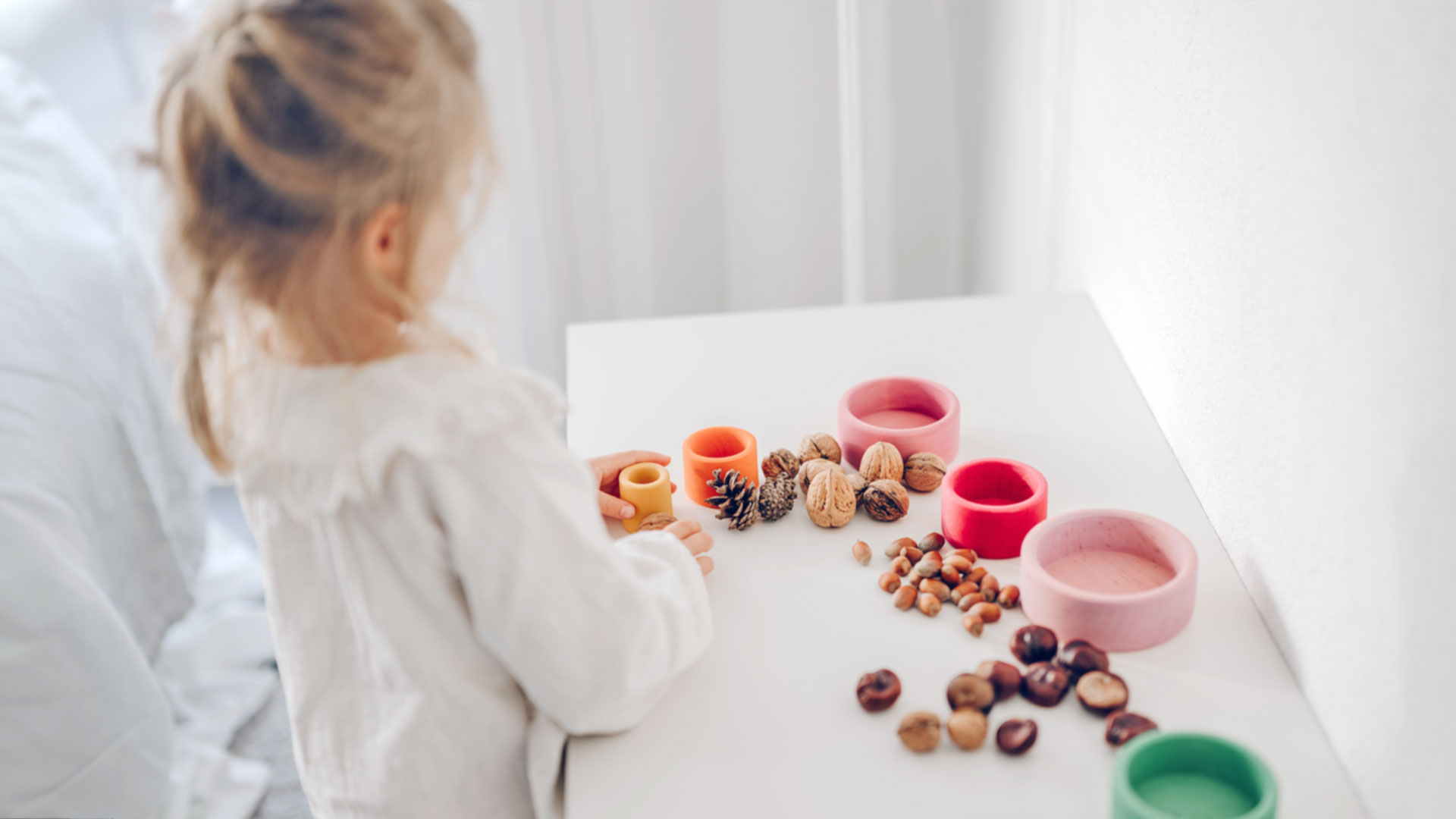
Children are individuals. Depending on their age, stage of development and personal interests, they want to explore and understand the world we live in.We parents (grandparents, aunts, uncles, carers or teachers may also feel addressed at this point) play an important role in this. If we want to encourage the youngest children in the Montessori way, we first need to observe their interests and abilities closely. Only in the second step do we provide a so-called prepared environment with carefully designed materials and activities based on our observations. This allows children to learn independently, at their own pace and without constant adult intervention. But which materials and activities are suitable? In this article, we present various Montessori ideas, which we have categorised by age. Nevertheless, you are the expert on your child and know their interests and abilities best. It is therefore quite possible that a kindergarten child will be interested in the toddler or pre-school category. The key here is to observe carefully and filter out the right ideas for your child. Have fun with it!
1. Montessori ideas for toddlers (1 to 2 years)
From the first birthday onwards, your little one is officially considered a toddler. Not only in everyday life can you now support your offspring, but there are also many Montessori-inspired playful ideas that are both fun and aid in acquiring new skills. Building blocks with simplified designs can be seamlessly incorporated. Children aged 1-2 years show particular interest in the following activities:
- Loading and unloading
- Sorting
- Imitating
- First building & stacking
- Looking at picture books
Offer your child a selection of wooden building blocks in a basket. It will have a lot of fun repeatedly loading and unloading the blocks. Through constant repetition, hand-eye coordination improves.
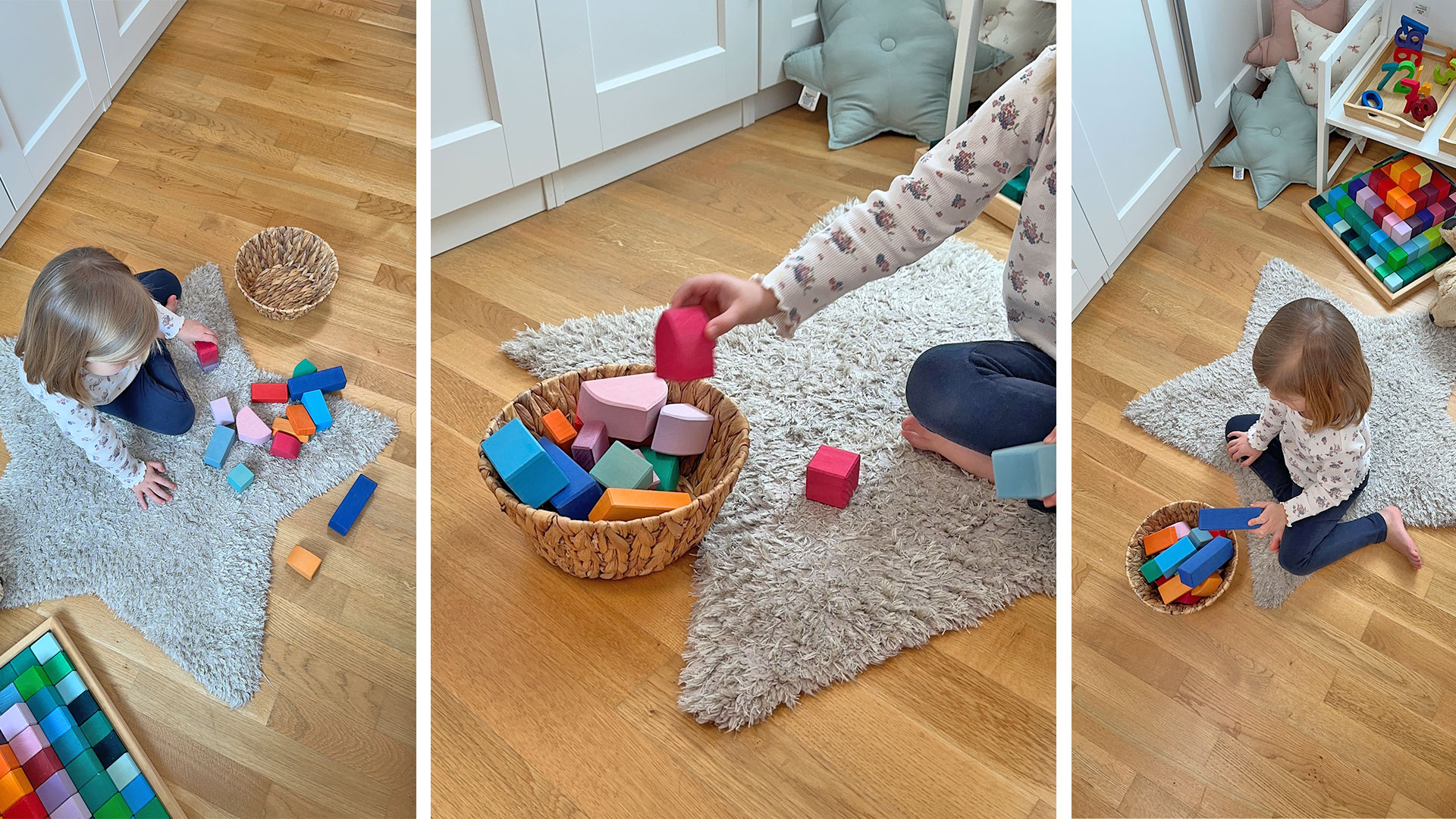
What I don't see is also not there – or is it? The mental ability to understand that objects or people do not completely disappear once they leave our field of view is a milestone in child development. With a simple game idea, you can help your baby grasp the concept of object permanence. You don't necessarily have to buy an expensive Montessori toy exclusively for this purpose. You can implement this small Montessori DIY with GRIMM'S Giant Building Blocks. And then use the blocks again for stacking.
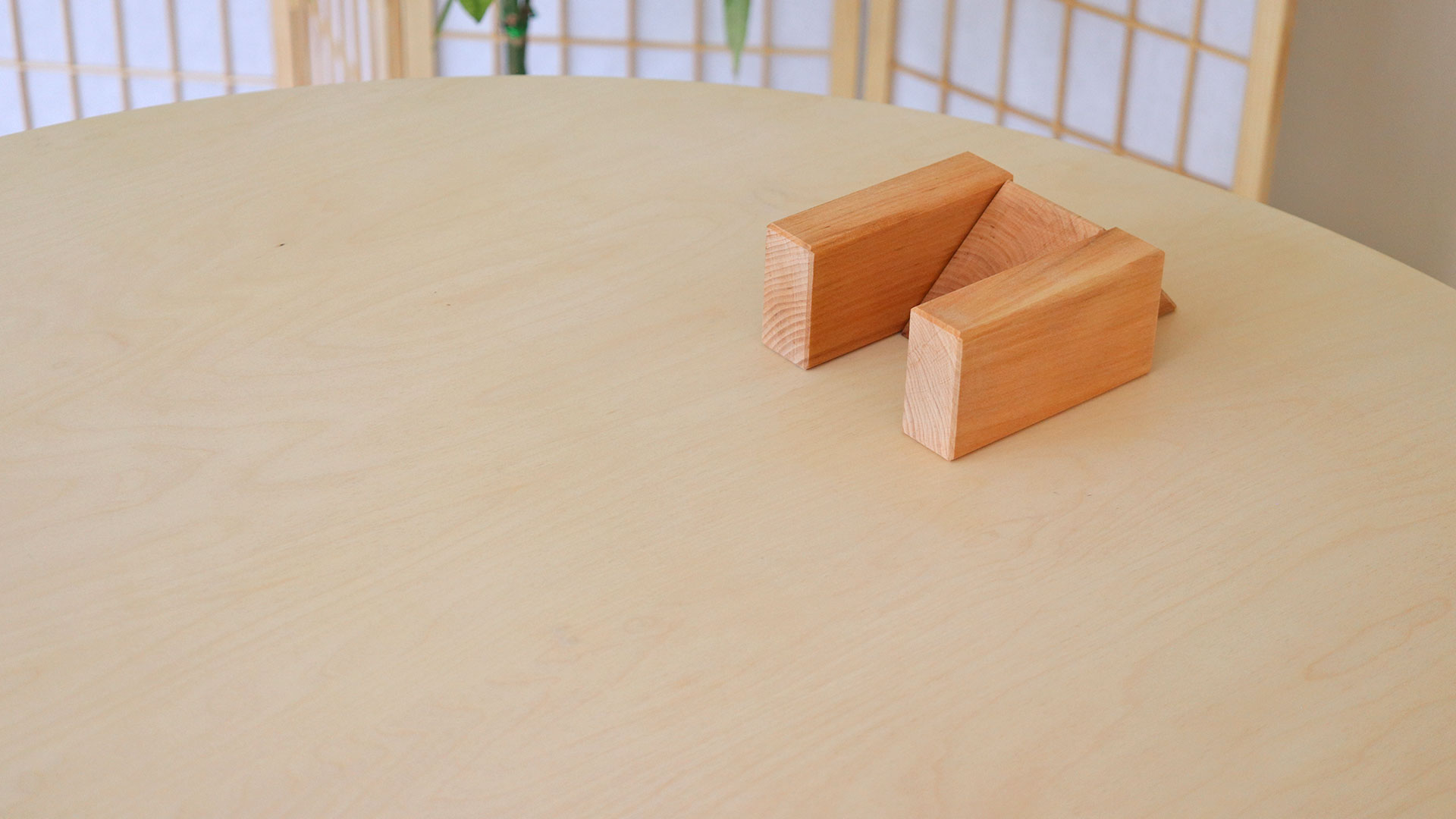
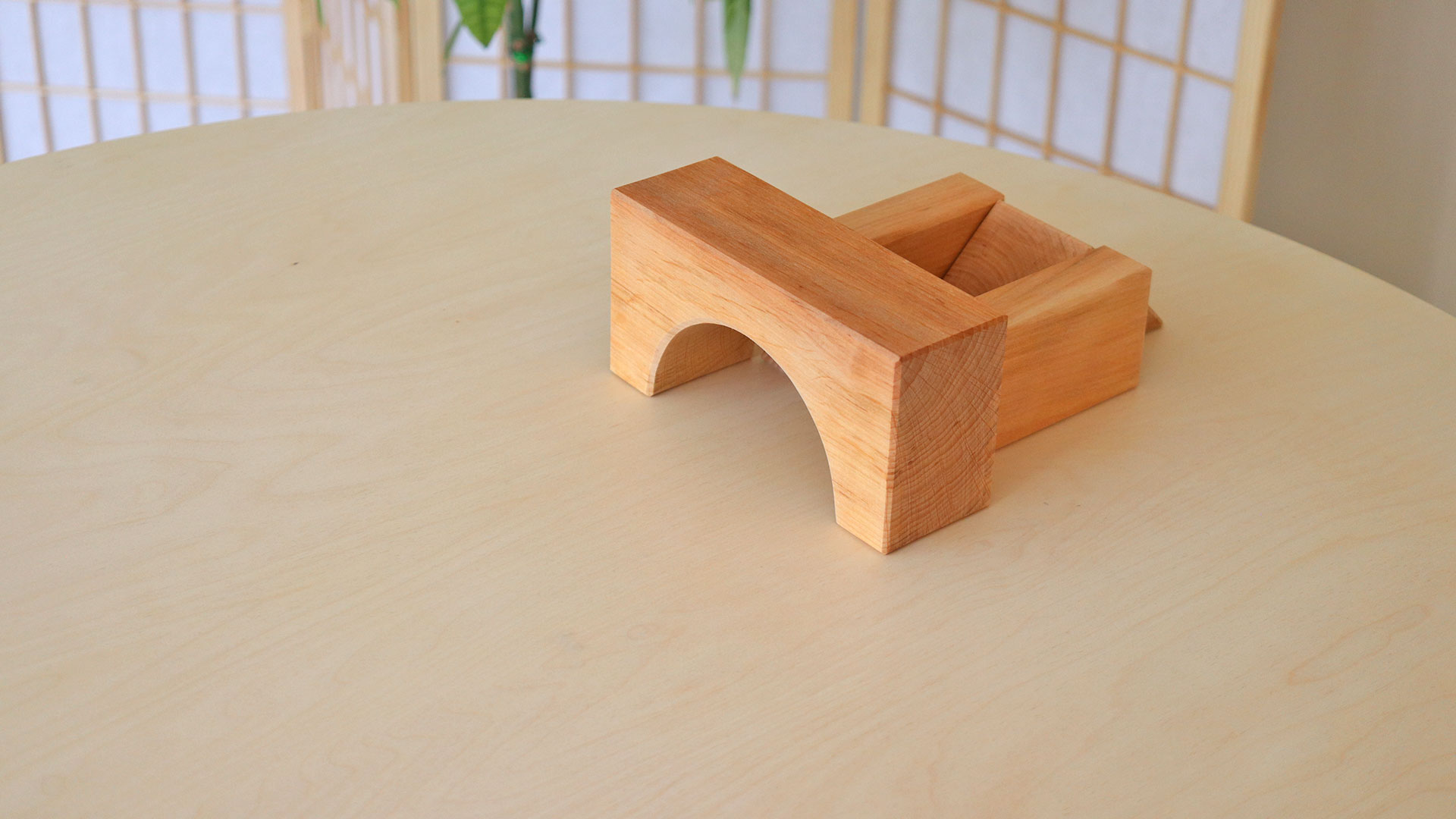
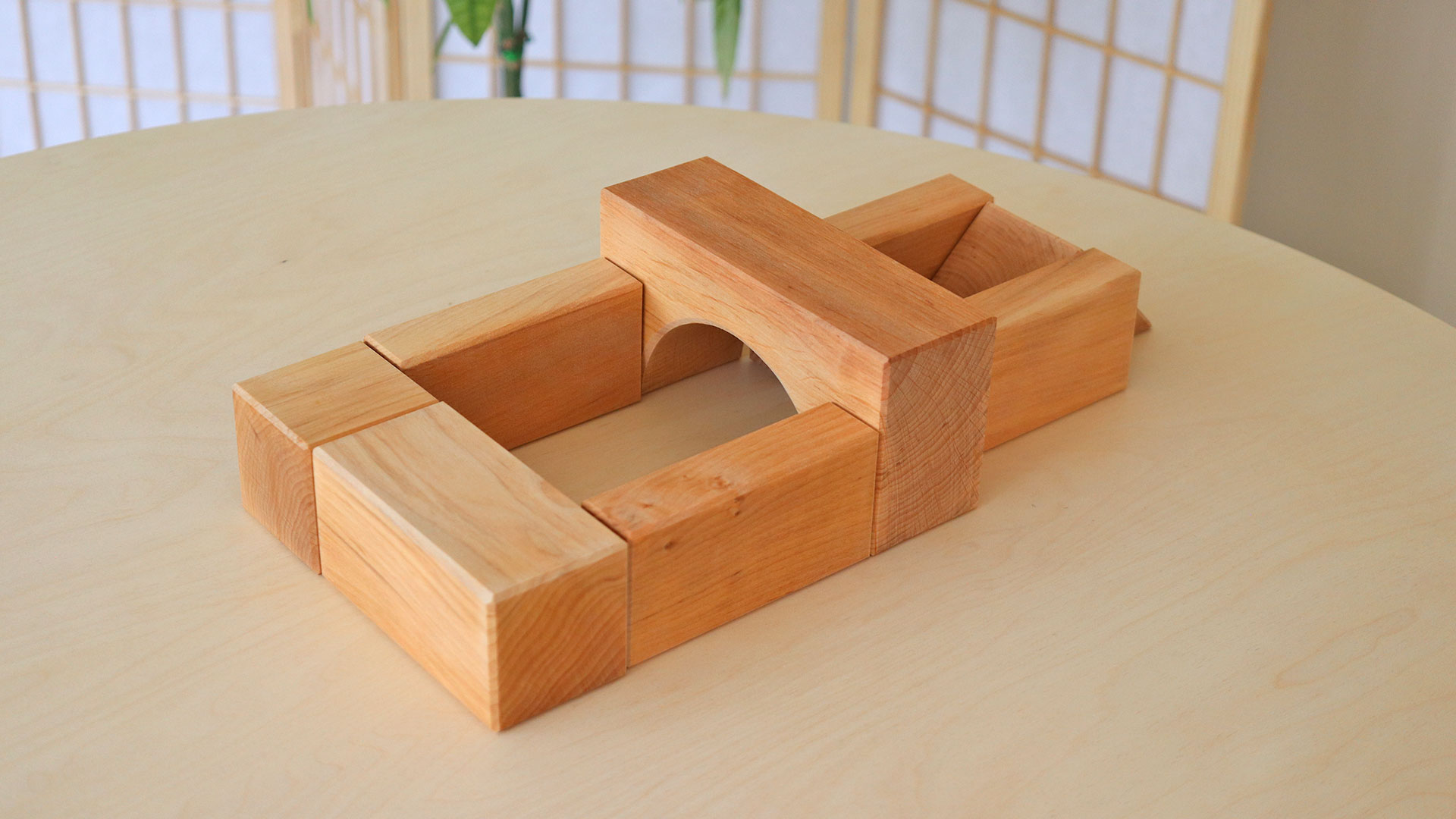
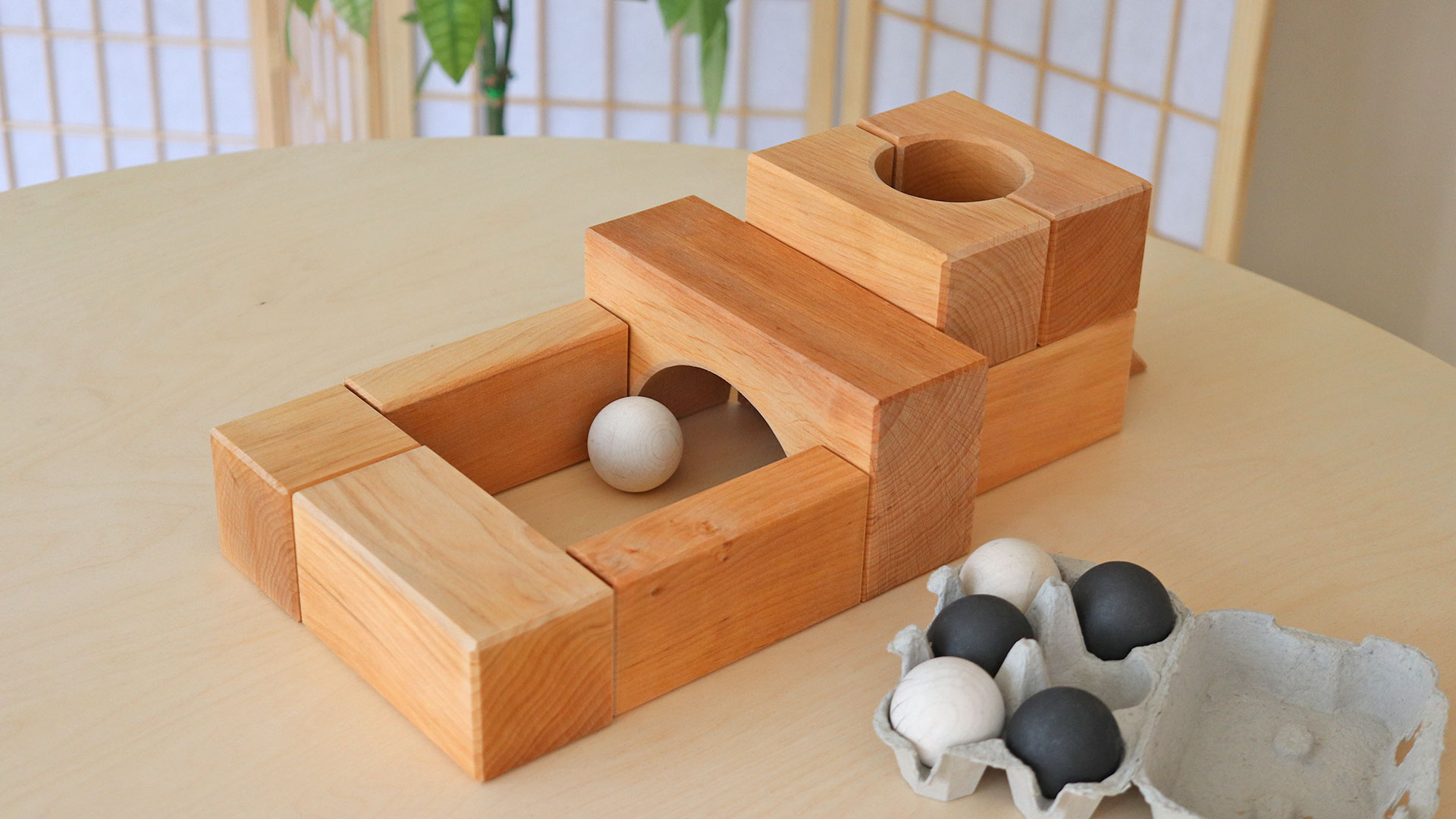
Follow our picture instructions and let your little one experiment: Insert a wooden ball into the round opening, it briefly disappears, and then reappears. This signifies: Not everything that briefly disappears remains lost. Things (or people) are still there, albeit in a different place.
Whether by colour, size, or shape – every day presents numerous opportunities to categorize things. Prepare a sorting game in Montessori style by setting up various-sized boxes and sorting materials of different sizes – for example, nuts. You can let your child experiment freely or provide more specific instructions by placing one type of nut in each container, which your child then matches with the remaining nuts. With this Montessori idea, your child learns about small, medium, and large sizes and improves hand-eye coordination. You can accompany this activity with language, saying something like: "Yes, the medium-sized chestnut goes into the middle box."
Important: Do not correct your little one if a nut is mistakenly placed, but give them the opportunity to notice and correct the error themselves. You'll be amazed at how well your capable toddler can handle it on their own.
Oh, and: Of course, this game idea must be supervised by an adult, as the oral phase in children under three years old is still ongoing, and there is a possibility that small, swallowable parts may end up in the mouth.
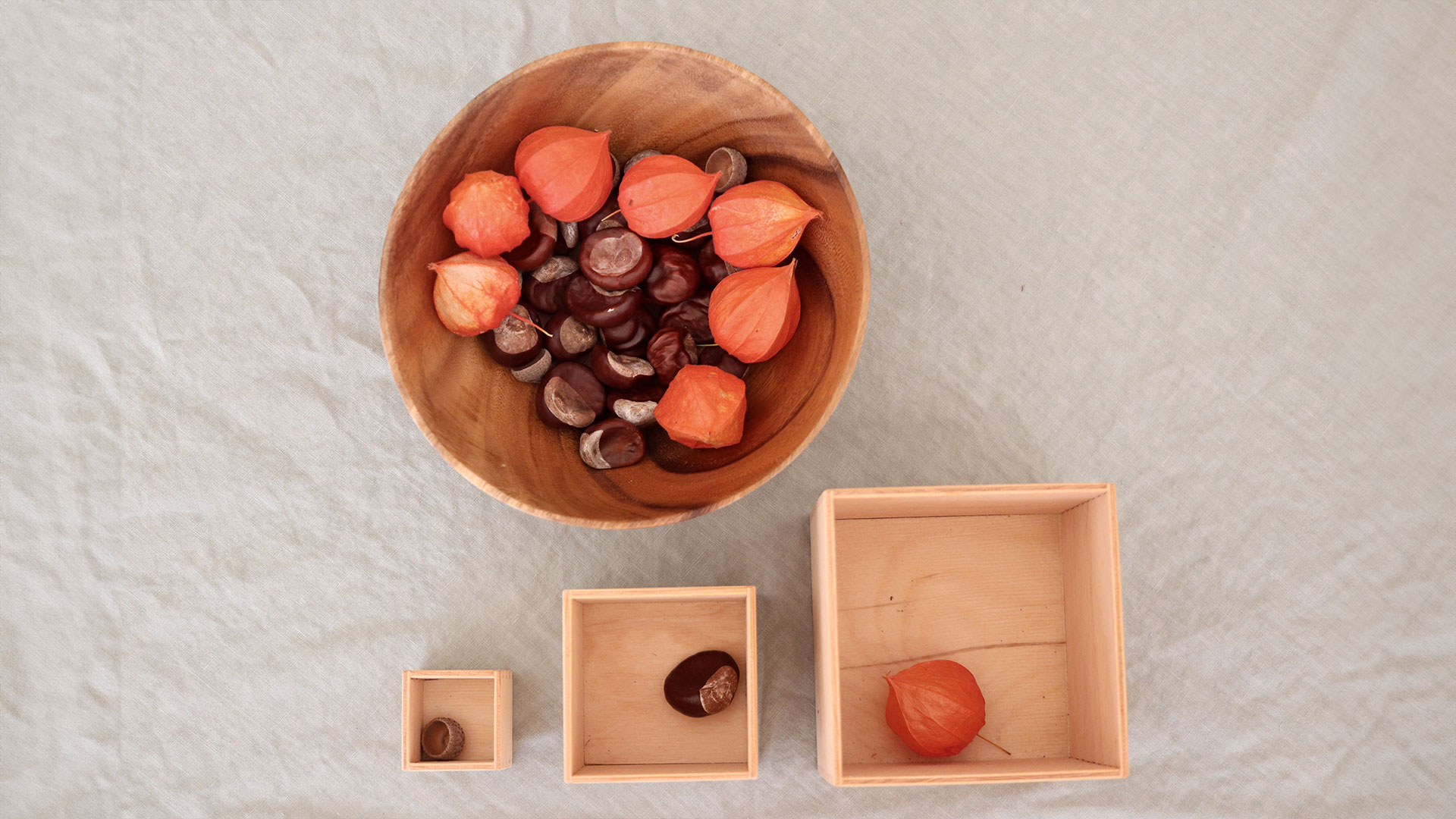
2. Montessori ideas for kindergarten children (3 to 4 years)
At three years old, your child has entered the kindergarten age, and the oral phase has ended – or is at least soon coming to an end. If you want to engage your child meaningfully after kindergarten or on weekends, Montessori trays are particularly suitable. In this approach, all materials needed for a Montessori activity are placed on a suitable tray. This keeps the "ingredients" organized, allowing your child to focus on that specific activity. The following activities are particularly exciting for children aged 3 to 4 years:
- Pretend play
- Movement to music
- Threading
- Three-dimensional building
- Placing pictures and puzzles
Beads, buttons, or short penne pasta: Kindergarten children take great joy in threading things onto a string, creating playful necklaces proudly worn as homemade jewelry. Start threading exercises with easily graspable items and larger holes, gradually increasing difficulty as your child overcomes initial challenges. Prepare the Montessori tray by offering large wooden buttons in a basket along with an appropriate string. Your child will quickly grasp what to do and embark on their first threading attempts. Tip: If you don't have a string with an end piece at home, you can wrap a short strip of tape around the end of the string to prevent fraying.
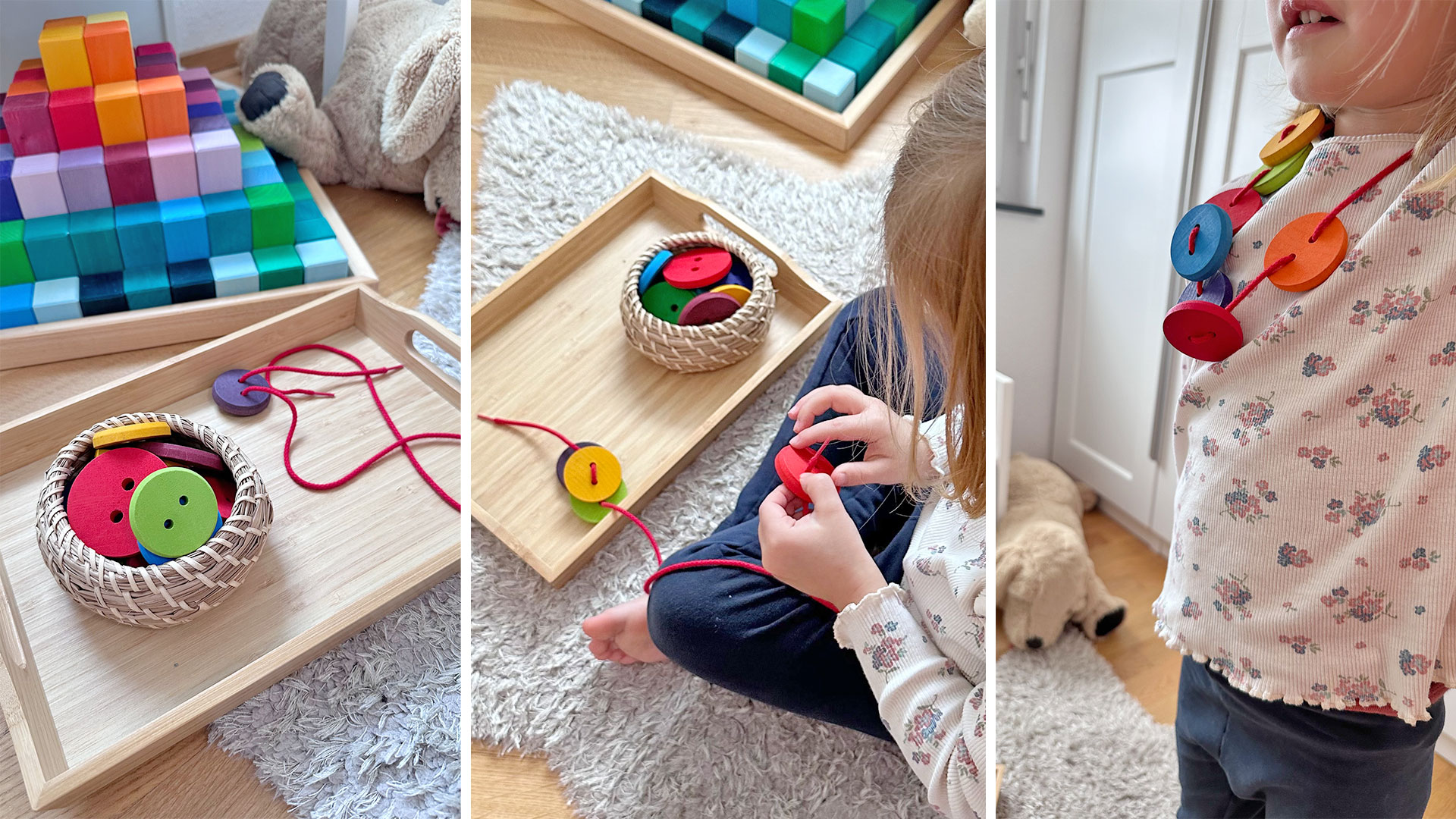
In kindergarten age, most children are already quite adept at matching shapes and colours. But how about letting your child help create a new game idea? Everything you need is already at home: a sheet of paper, a pencil, and a few differently shaped building blocks. The task is to trace around the blocks with the pencil. After that, put the blocks in a basket. The aim of the game is to match the blocks to the drawn shapes.
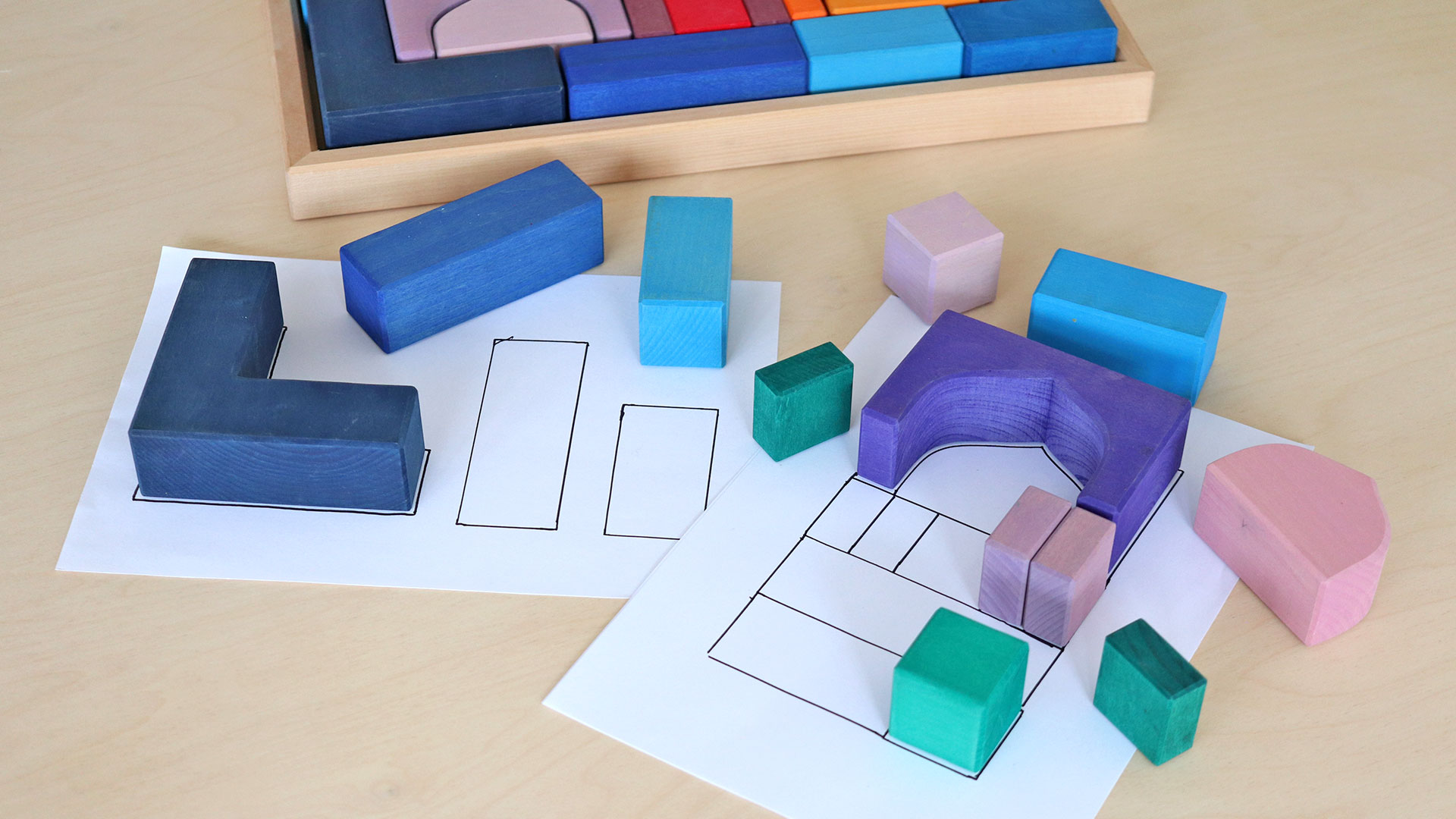
Is your child a true puzzle enthusiast and can solve almost every puzzle game by heart? Then a building block set might be the perfect play material for you. It includes differently shaped blocks that come in a wooden frame. Once emptied, the blocks can be puzzled back into the frame in numerous ways. Since there is no right or wrong way to do it, the puzzle doesn't get boring quickly and encourages the discovery of new variations over and over again.
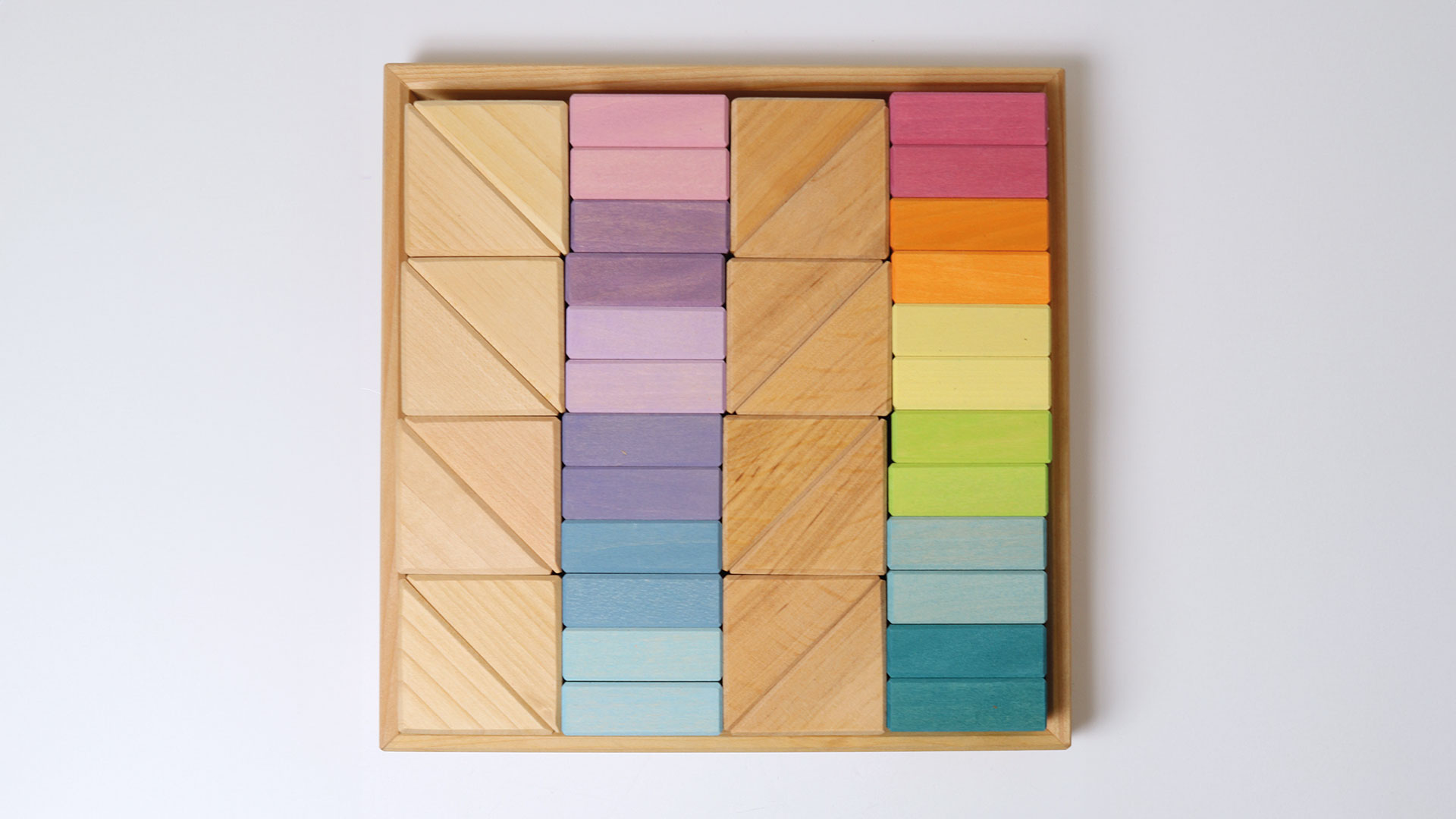
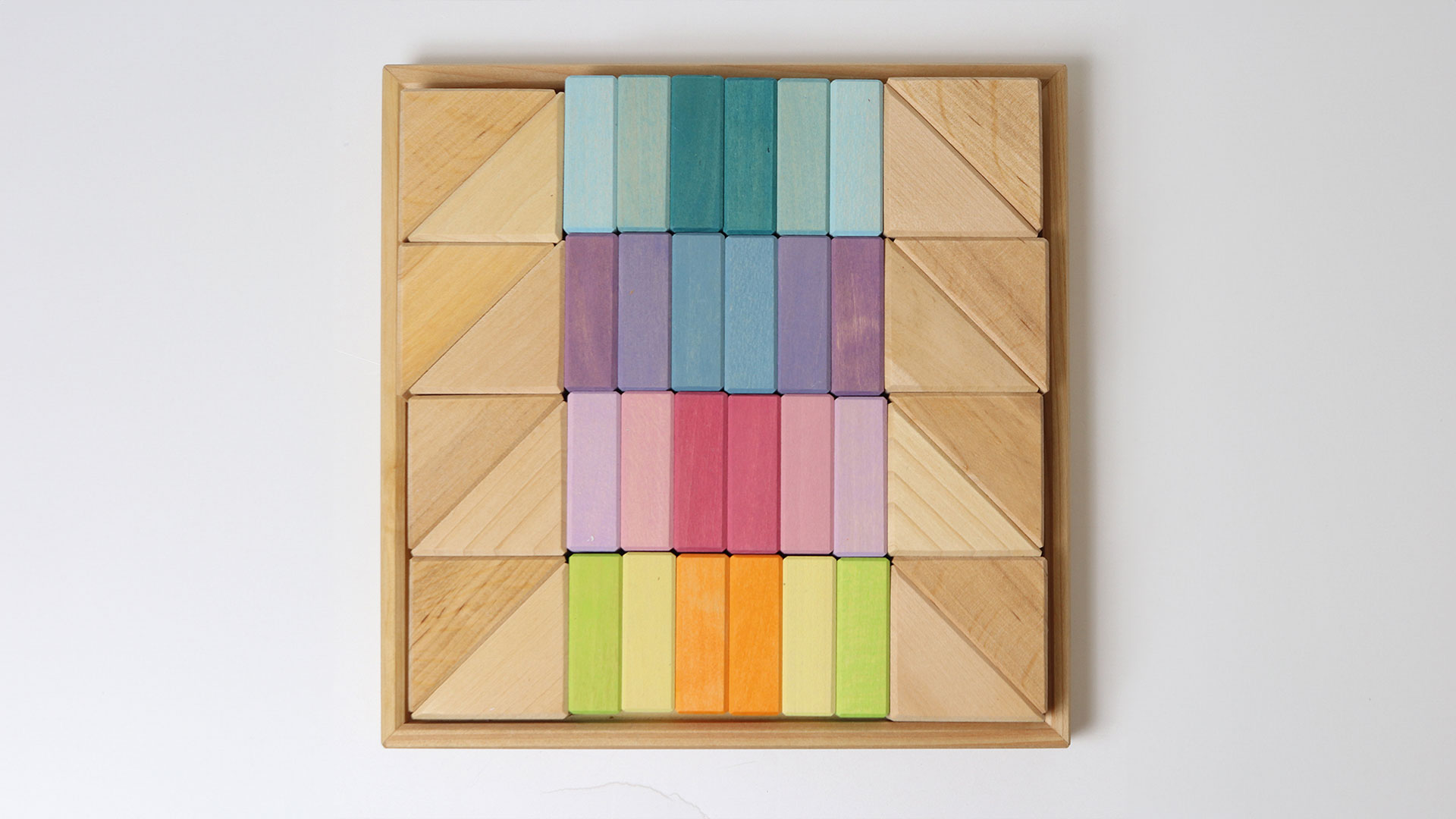
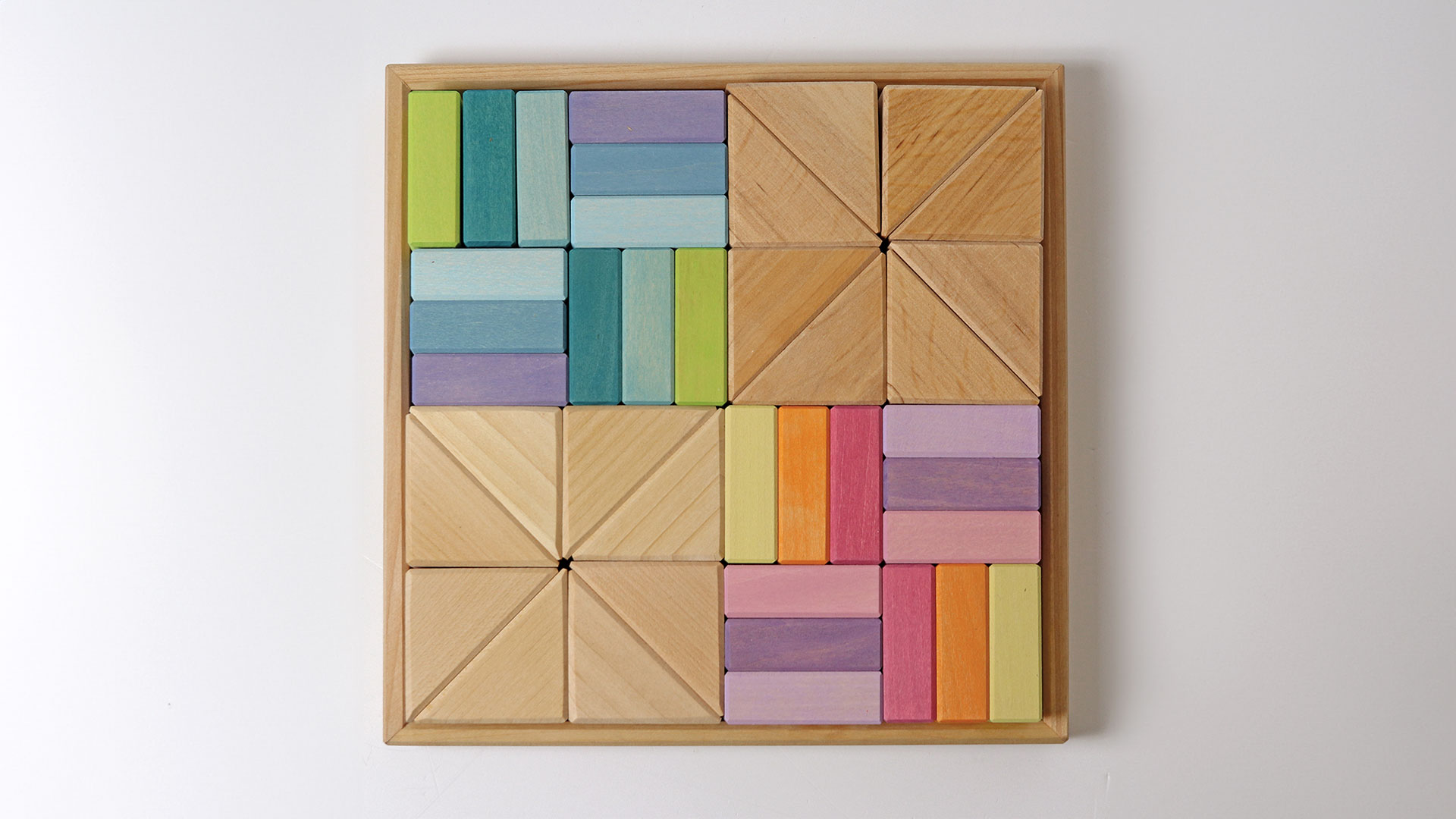
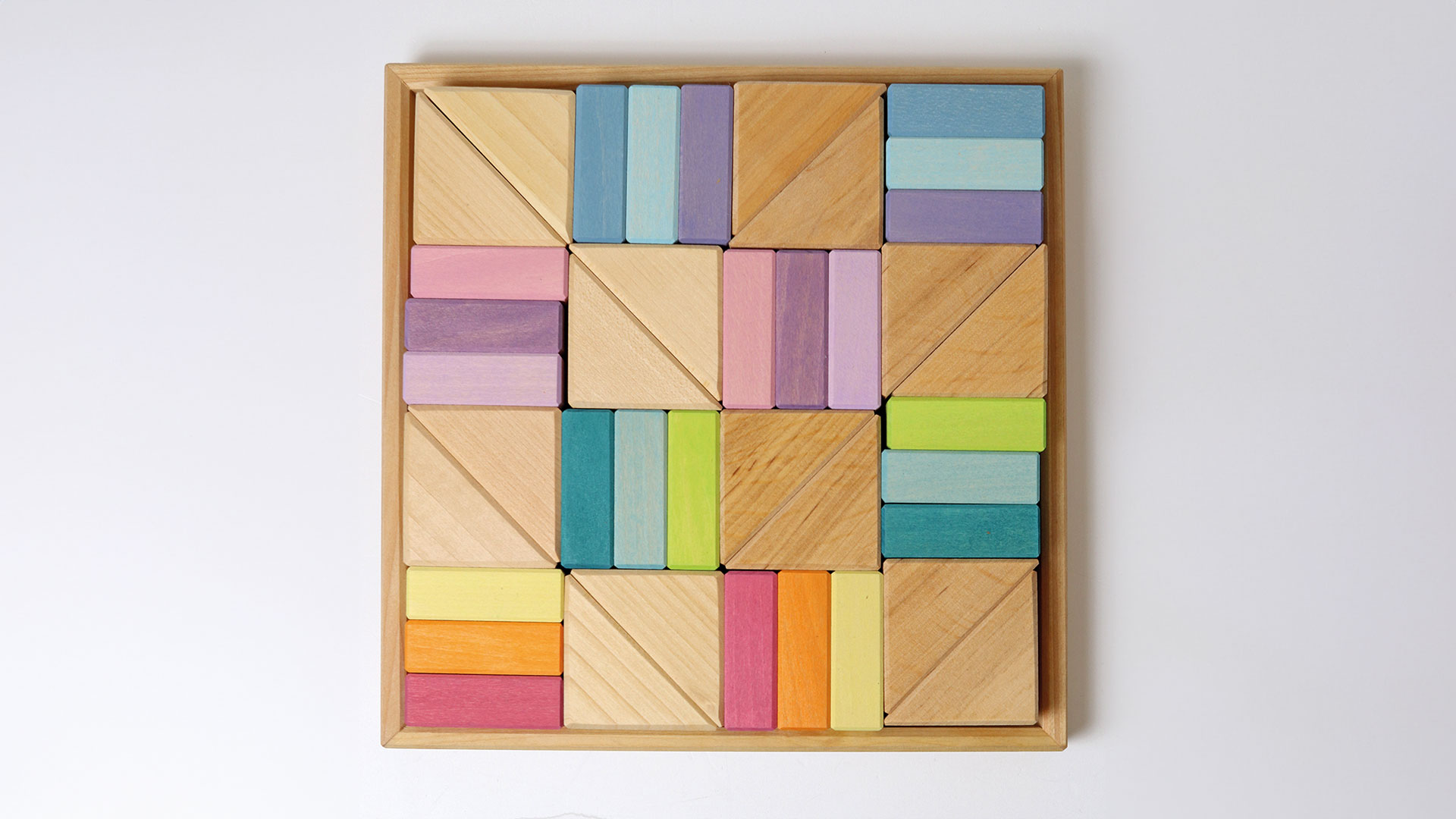
3. Montessori ideas for pre-school children (5 to 6 years)
In the preschool age, many children already show initial interest in numbers, letters, and the world we live in. Seize this sensitive phase to quench your child's thirst for knowledge in a playful manner.
- Deepened interest in the world and stories
- Advanced building
- Learning letters
- Learning numbers
Minimally designed building materials can be used in various ways. How about creating a self-designed small world play? You can either prepare it in advance or come up with ideas together. Depending on your child's interests, everyday situations such as a traffic scene with pedestrians, cars, tunnels, etc., can be recreated. A farm scene where existing animal figures can be integrated is also possible. Either way, through active engagement with self-built play worlds, children can better understand processes and relationships.
Tip: Those looking for inspiration for small world play ideas can find it on our dedicated Pinterest board. Alternatively, our building worlds such as Polar Light or Desert Sand offer opportunities to explore life in the far north or the desert.
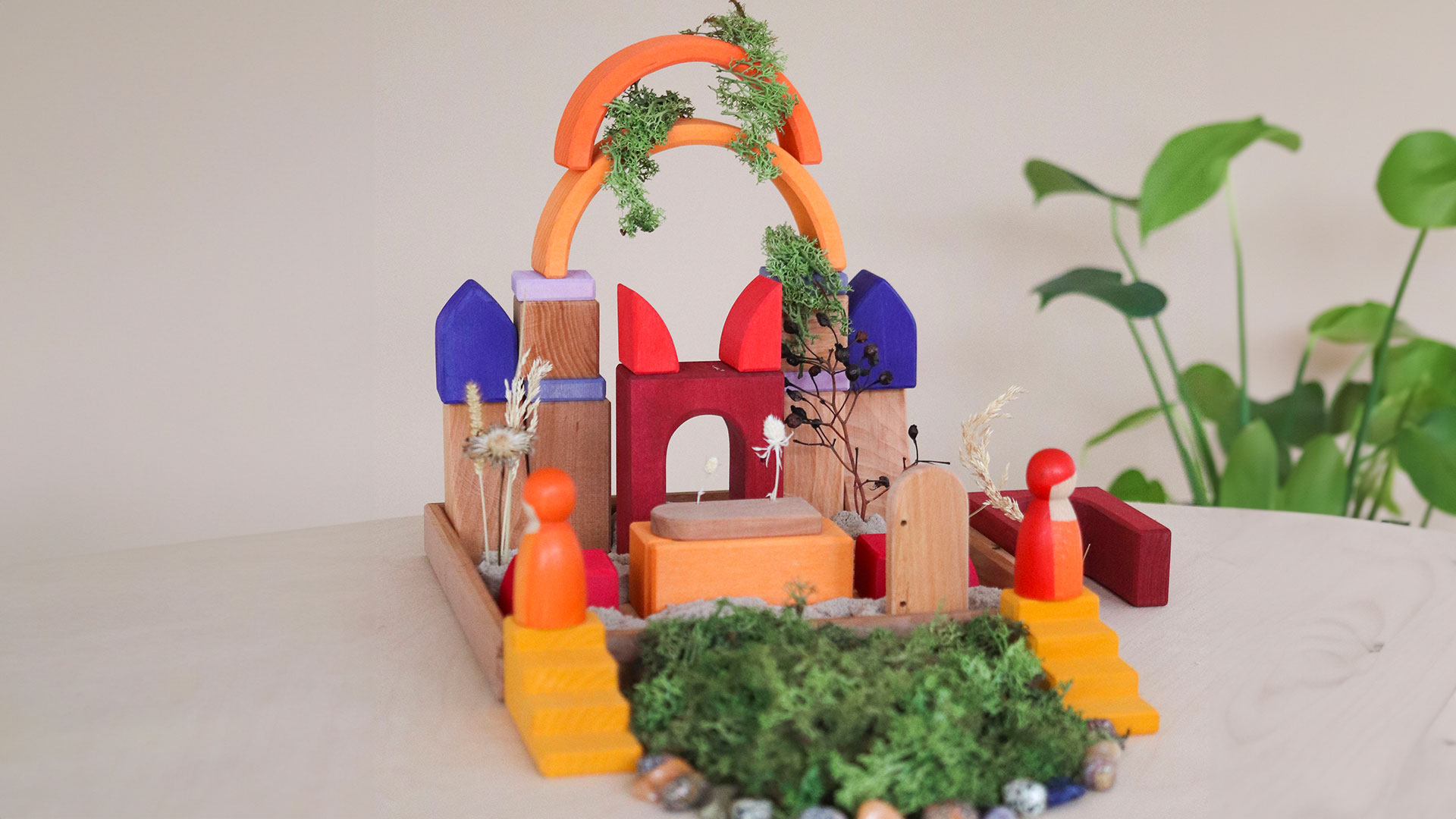
A – B – C – D – E. I'm in the jungle in a coconut tree. Rhymes and songs expose children to the alphabet at an early age. When they can literally touch the 26 letters, they quickly develop a better sense of them, and the differences between C and G or B and P become clear. An ABC game where the letters can be individually taken out and touched is the ideal play material for little letter enthusiasts. After an initial introduction, various Montessori ideas can be tried with the letters. Two examples:
1. Hidden Letters: Cover the letters. The child puts their hands under the cover, picks up a letter, and touches it until they can make a guess. Then the cover is removed, and your child can visually check whether it was correct.
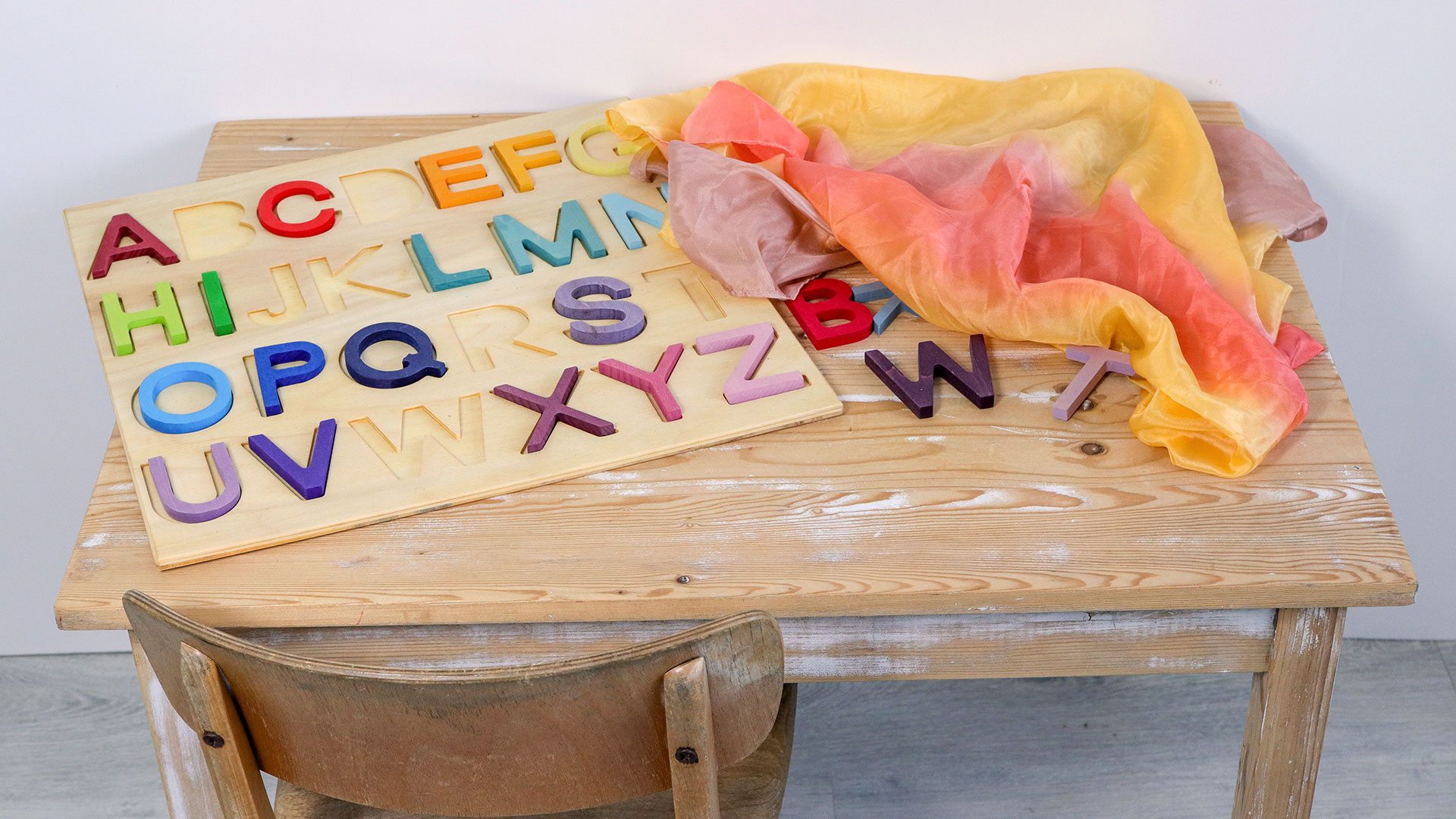
2. Z for Zebra: Walk through your home and gather six small objects that start with different letters. Now, place them together with the matching wooden letters from the ABC game in a basket. Your child's task is to find the corresponding pairs.
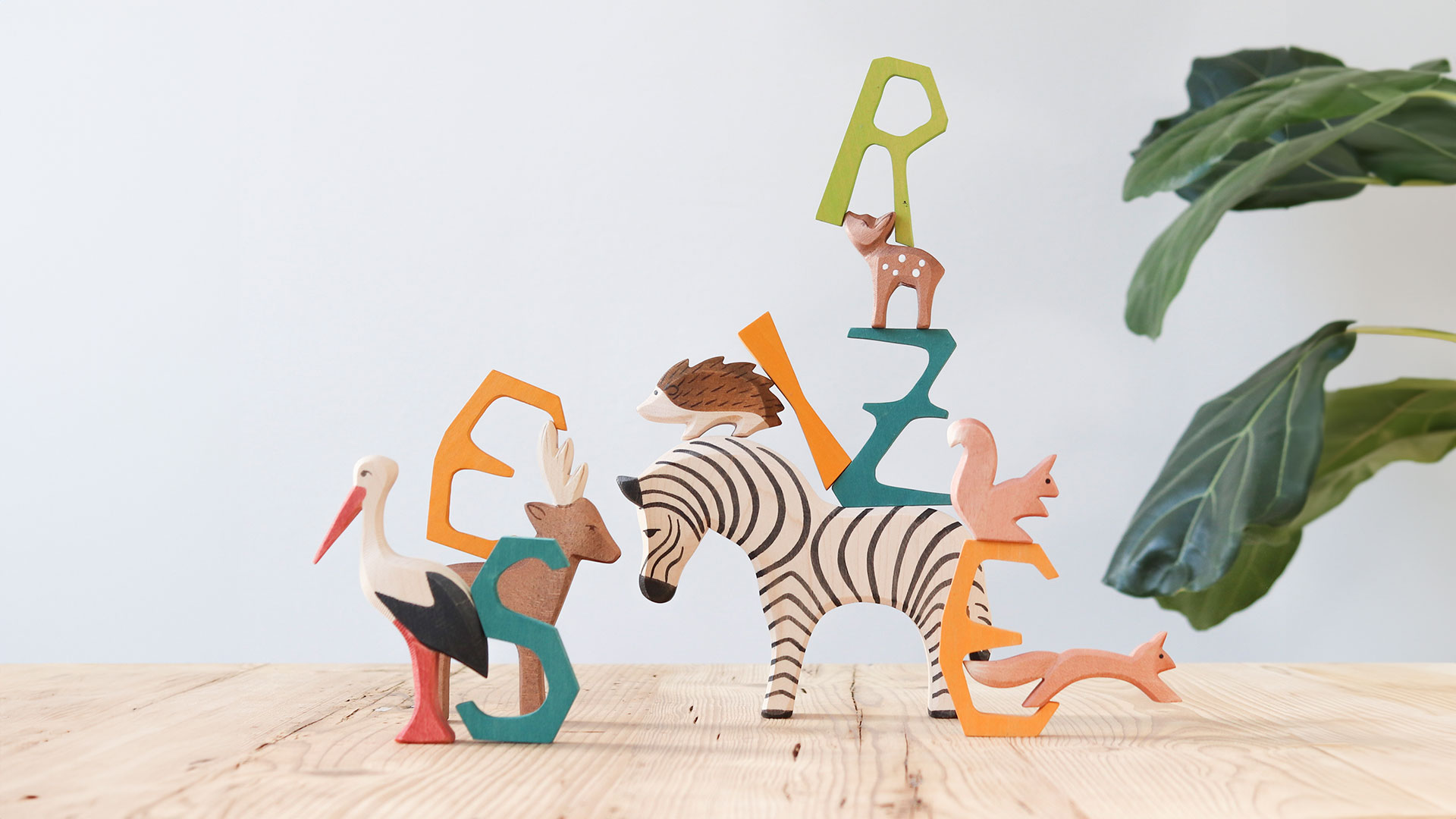
Counting up to 10 is something your child can probably do already, and surely it has experimented with imaginary amounts while playing "shopping." However, the little ones often lack an understanding of realistic quantities: a scoop of ice cream is sold for 9 euros, whereas three scoops of ice cream are priced at 2 euros. With number-inspired Montessori ideas, you can help your preschooler develop a better sense of numbers and quantities. Start with easy tasks and increase the difficulty only when your child is ready and interested. Everything is possible, but nothing has to! Two examples:
1. Prepare a tray with the following materials: 1 wooden frame, differently coloured wooden numbers 1, 2, and 3, a bowl with filling material (e.g., corn kernels), small wooden beads in the same colours as the numbers, and a pair of tweezers. Your child's task is to place a number in the wooden frame and then use the tweezers to pick the corresponding number of wooden beads from the bowl. Ensure that there are only as many beads in the bowl as needed. This way, your child can perform a self-check.
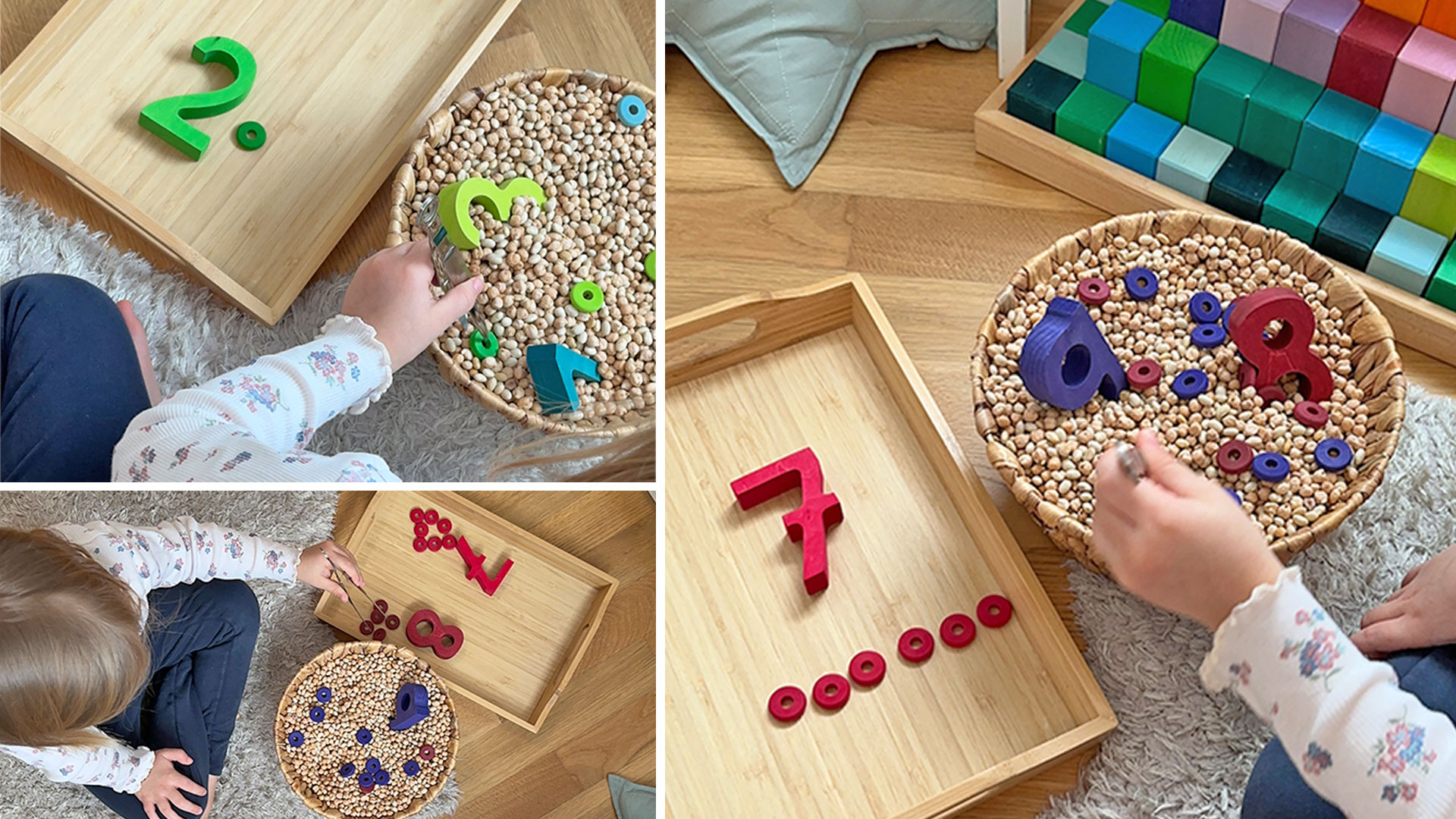
2. You are true GRIMM’S fans, and the classic rainbow is in the children's room? Great, then you can use your favourite toy for this idea. You'll need: A 10-piece rainbow – for example, from GRIMM’S World of Numbers (if you have a 12-piece rainbow, simply put the smallest and the largest bow aside), many loose small parts (e.g., 10 x beads, 9 x rings, 8 x hazelnuts, etc.), and wooden numbers. Your child can now lay out the arches on the floor. The smallest number "1" is assigned to the smallest arch, the second smallest number "2" is assigned to the next larger arch, and so on. Finally, the task is to place the loose small parts into the matching arches.
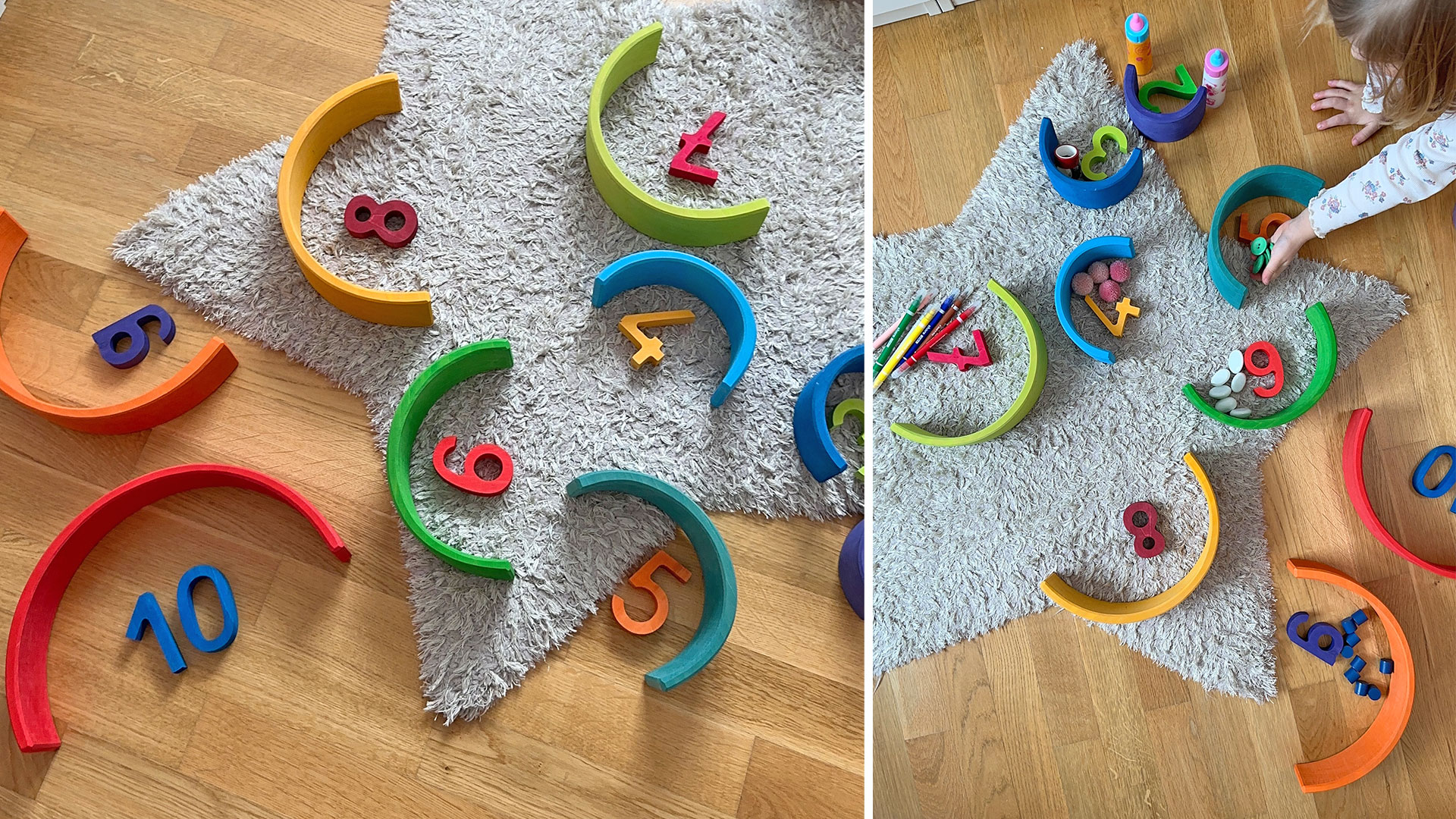
4. Montessori ideas for school children (7 to 9 years)
Most children are looking forward to their school days and really enjoy understanding and applying the world of numbers and letters from the ground up. The following areas are of particular interest to seven to nine-year-olds:
- Learning to read and write
- Learning arithmetic
- Challenging constructions
Understanding three-dimensional construction on paper can be quite challenging. It becomes clearer when children can take matters into their own hands - literally. With the following Montessori idea and GRIMM'S Rainbow Mosaic, challenging building becomes understandable.
And this is how it works:
- Print out the pages and cut them in half: click here for the free download.
- Place the 3D graphic, the matching ground plan and a sufficient number of cube-shaped building blocks on a tray.
- The task is now to recreate the 3D graphic on the ground plan.
- At the end, use the control card to recognise whether the task has been solved correctly.
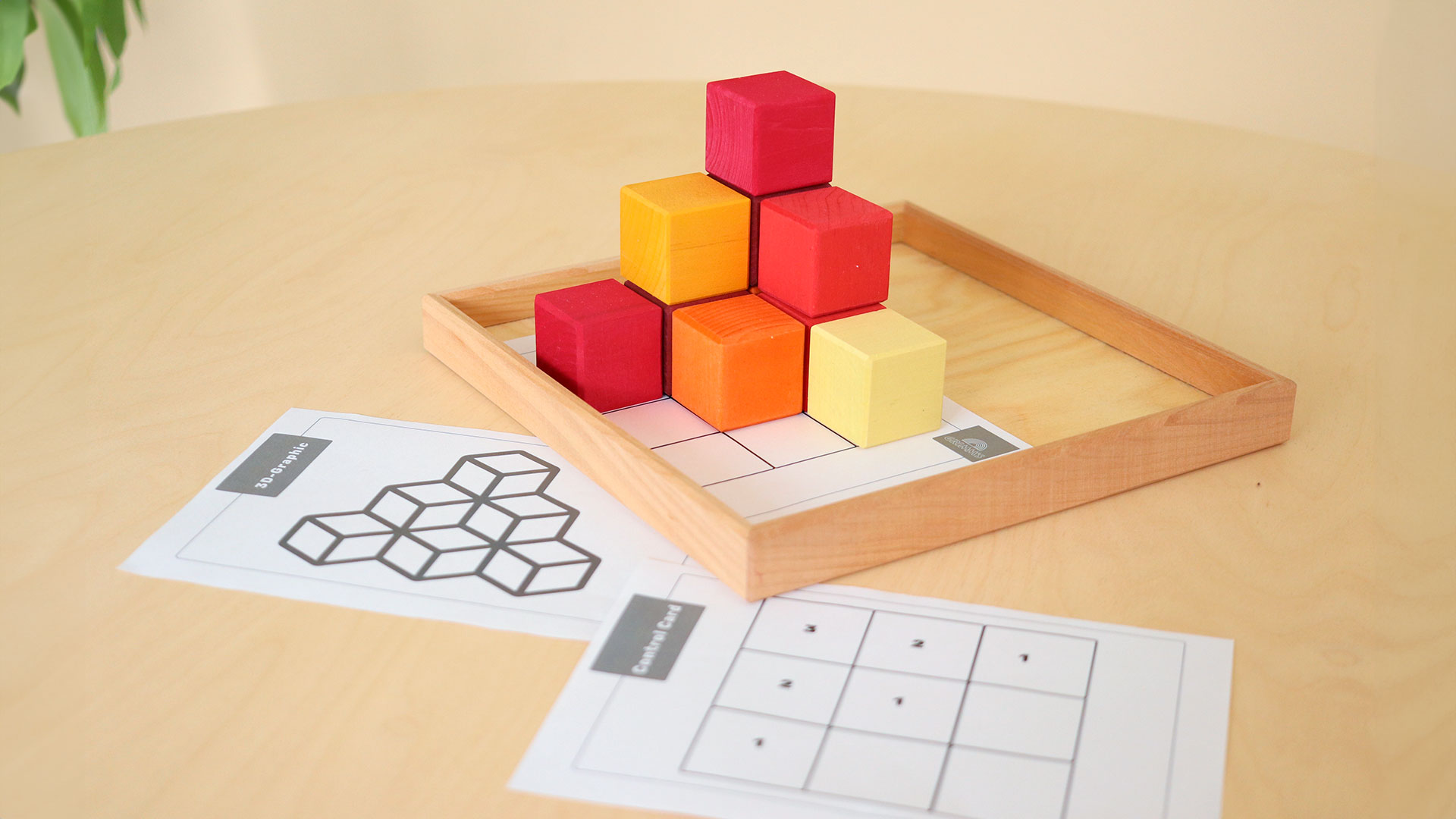
A practical learning toy for on the go is GRIMM’S Creative Set Square. Although it is already pre-assembled – and thus not a Montessori idea in the strict sense – I don't want to withhold it from you at this point because: The puzzle toy is ideally suited for playfully learning and understanding 2D and 3D learning content. The 12 differently shaped building blocks in the wooden frame come with a corresponding task booklet that illustrates various complex constructions to be recreated. Fine motor skills and spatial thinking are trained in the process.
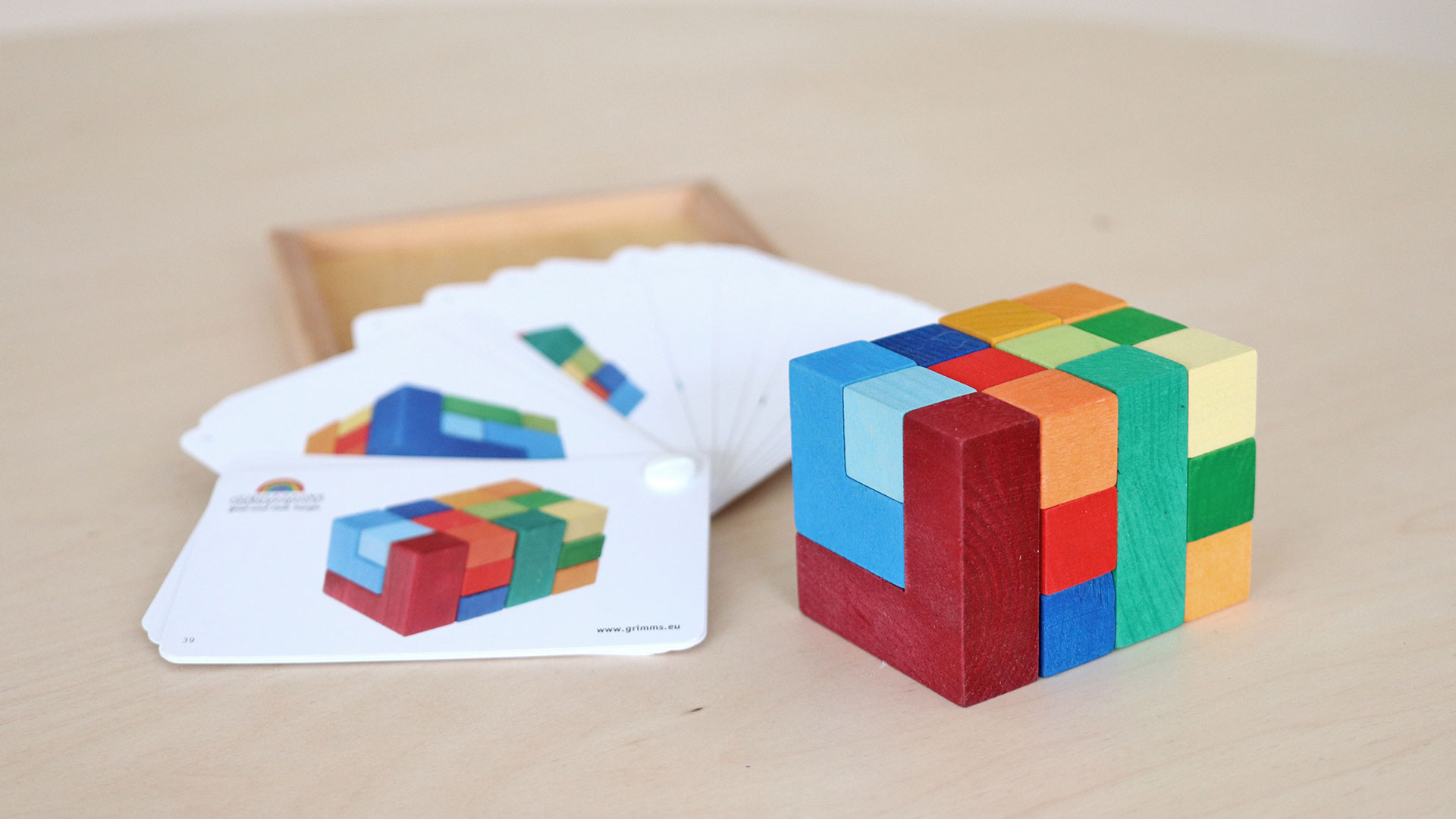
Did you like this post and would you like to see more Montessori-inspired play and activity ideas with GRIMM'S? Then visit our ever-growing Montessori-themed Pinterest board and get inspired for all ages and developmental stages. Have fun with it!

